Loupe
A loupe (/ˈluːp/ LOOP) is a simple, small magnification device used to see small details more closely. Unlike a magnifying glass, a loupe does not have an attached handle, and its focusing lens(es) are contained in an opaque cylinder or cone or fold into an enclosing housing that protects the lenses when not in use. Loupes are also called hand lenses.
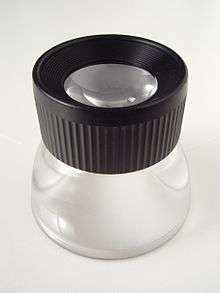
Optics
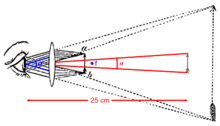
Three basic types of loupes exist:
- Simple lenses, generally used for low-magnification designs because of high optical aberration.
- Compound lenses, generally used for higher magnifications to control optical aberration.
- Prismatic, multiple lenses with prisms.
Uses
Loupes are used in a number of industries, notably the jewelry trade, watchmaking, photography, printing, dentistry, education and ophthalmology. Loupes are also used in academia and life sciences, such as geology and biology. Amateur naturalists may also find a hand lens or a loupe a useful tool when looking at or identifying species. They are also used in numismatics and stamp collecting.
Jewelers and gemologists
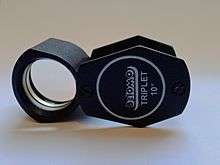
Jewelers typically use a monocular, handheld loupe in order to magnify gemstones and other jewelry that they wish to inspect.[1] A 10× magnification is good to use for inspecting jewelry and hallmarks[1] and is the Gemological Institute of America's standard for grading diamond clarity. Stones will sometimes be inspected at higher magnifications than 10×, although the depth of field, which is the area in focus, becomes too small to be instructive.[2] The accepted standard for grading diamonds is therefore that inclusions and blemishes visible at 10× impact the clarity grade.[3]
Watchmaking
Loupes are employed to assist watchmakers in assembling mechanical watches. Many aspects require the use of the loupe, in particular the assembly of the watch mechanism itself, the assembly and details of the watch dial, as well as the formation of the watch strap and installation of precious stones onto the watch face. Some families like Kruder which were into watchmaking and working with glass started producing high-quality loupes in addition to their watches
Photography
Analog (film) photographers use loupes to review, edit or analyze negatives and slides on a light table. Typical magnifications for viewing slides full-frame depend on image format; 35 mm frames (24×36 mm slides to 38×38 mm superslides) are best viewed at ca. 5×, while ca. 3× is optimal for viewing medium format slides (6×4.5 cm / 6×6 cm / 6×7 cm). Often, a 10× loupe is used to examine critical sharpness. Photographers using large format cameras also use a loupe to view the ground glass image to aid in focusing. DSLR camera users also use loupes to help to identify dust and other particles on the sensor, in preparation for sensor cleaning.
Printing
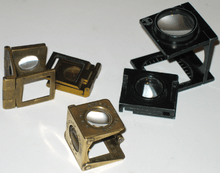
Offset and flexographic printing see frequent use of loupes in order to carefully analyze how ink lies on paper. Strippers use loupes in order to register film separations to one another. Pressmen use them to check registration of colors, estimate dot-gain, and diagnose issues with roller pressure and chemistry based on the shape of individual dots and rosettes.
Dentistry
Dental loupes aid dentists, hygienists, and dental therapists to devise accurate diagnoses of oral conditions and enhance surgical precision when completing treatment. Additionally, loupes can improve dentists' posture which can decrease occupational strain.[4]
Dental caries, also known as cavities, are most accurately identified by visual and tactile examination of a clean, dry tooth.[5] Magnification enables dentists to improve their ability to differentiate between a stain and a cavity. Cavities are rated and scored based on their visual presentation.[6] If magnification is too high diagnosis becomes difficult due to the small field of view. Ideal magnification for diagnostic purposes is up to 2×.[7][8] Treatment of dental caries, periodontal disease, and pulpal disease are all aided by magnification.
The dental specialty of endodontics has performed the vast majority of research regarding magnification in dentistry. Because the identification of accessory canals in addition to the primary pulp canals is essential to complete nonsurgical root canal therapy, magnification provides dentists enhanced visualization to locate and treat more obscured canals.
Treatment of periodontal disease is achieved by removing calculus deposits, plaque and therefore bacteria which causes inflammation and subsequently bone destruction. In severe cases, surgery to reduce pocket depth is indicated. Periodontists and hygienists must visualize plaque and calculus to remove it. Magnification can assist dentists and hygienists with identification and removal of plaque and calculus in addition to improving visualization for periodontal surgery.[9]
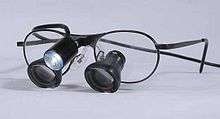
As dental professionals use both hands in performing dental procedures, dental loupes are binocular and usually take the form of a pair of glasses. Some dental loupes are flip-type, which take the form of two small cylinders, one in front of each lens of the glasses. Other types are inset within the lens of the glasses. A typical magnification for use in dentistry is 2.5×, but dental loupes can be anywhere in the range from 2× to 8×.
Together with proper access to the oral cavity, light is an important part of performing precision dentistry. Because a dentist's head often eclipses the overhead dental lamp, loupes may be fitted with a light source. Loupe-mounted lights used to be fed by fiber optic cables that connected to either a wall-mounted or table-top light source. Newer models feature a more convenient LED lamp within the loupe-mounted light and an electric cord coming from either the conventional wall-mounted or table-top light source or a belt clip rechargeable battery pack. Options for loupe-mounted cameras and video recorders are also available.[10]
Surgery

Surgeons in many specialties commonly use loupes when doing surgery on delicate structures. The loupes used by surgeons are mounted in the lenses of glasses and are custom made for the individual surgeon, taking into account their corrected vision, interpupillary distance and desired focal distance. Multiple magnification powers are available. They are most commonly used in otolaryngology, neurosurgery, plastic surgery, cardiac surgery, orthopedic surgery, and vascular surgery.
Geology
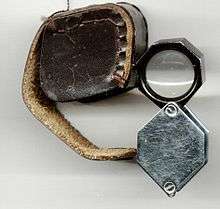
The loupe (hand lens) is a vital geological field tool used to identify small mineral crystals and structures in rocks.
Biology
Loupes are used by professional and amateur field biologists for help identifying species in field situations where a full-sized microscope is impractical, but the ability to observe small morphological characteristics is desired. Many floras and diagnostic keys for identifying plant or animal species recommend the use of a loupe, because taxa may be separated by minute details like the presence of hairs, shapes of hairs and glands.
Meteoritics
Scientists in the meteoritics and planetary science field as well as private collectors of meteorites use loupes as one of their primary tools in meteorite classification and study, and also for simple examination in the field during meteorite recovery.
Electronics
Due to the extremely small size of many modern surface-mount components used in compact electronics, engineers often use a loupe to inspect the completed circuit board for manufacturing defects such as solder bridging and missing or misaligned components. While soldering or reworking surface-mount components by hand a loupe can be used for identifying and aligning parts. Due to the ever-decreasing size of electronic components, magnification is increasingly required for circuit assembly.
Tattooing
Tattoo artists use loupes to inspect the quality of their needle tips. They do this to ensure the least amount of damage possible to the skin surface.
Numismatists and coin collectors
Loupes are an essential tool in both numismatics, the study of currency, and the related practice of coin collection. Coin collectors frequently employ loupes for better evaluation of the quality of their coins, since identifying surface wear is vital when attempting to classify the grade of a coin. Uncirculated coins (coins without wear) can command a substantial premium over coins with slight wear. This wear cannot always be seen with the naked eye. Numismatists can also employ loupes to identify some counterfeit coins that would pass a naked-eye visual inspection.
Philatelists and stamp collectors
Stamp collectors employ loupes to improve their ability to evaluate the quality of their stamps. Identifying surface, adhesive, and perforation is vital when attempting to classify the grade of a stamp. Mint stamps (stamps without cancellations) with no wear can command a substantial premium over mint stamps with slight wear. This wear cannot always be seen with the naked eye. Practitioners of philately, the study of postage and revenue stamps, also employ loupes to identify counterfeit stamps that would pass naked-eye inspections.
Sharpening
Sharpeners of knives or other edged or pointed tools may use a loupe to inspect the tool and ensure correct angle, straightness of the bevel, a sharp edge and/or point, and a polished finish.
See also
- Bioptic telescope
- Pocket comparator
References
- "Jewelry - How to Use a Loupe - Using Jewelry Magnifiers". Jewelry.About.com
- "10X Loupe for Gemologists and Jewelers". International Gem Society.
- "The 4C's Of Diamonds: Diamond Clarity". Leibish & Co.
- Friedman, Mark J. (2004-01-01). "Magnification in a restorative dental practice: from loupes to microscopes". Compendium of Continuing Education in Dentistry (Jamesburg, N.J.: 1995). 25 (1): 48, 50, 53–55. ISSN 1548-8578. PMID 15645879.
- "Diagnosis of Occlusal Caries: Part I. Conventional Methods". www.cda-adc.ca. Retrieved 2016-05-17.
- "ICCMS Caries Management" (PDF). www.icdas.org. ICDAS. Retrieved 17 May 2016.
- Neuhaus, K. W.; Jost, F.; Perrin, P.; Lussi, A. (2015-12-01). "Impact of different magnification levels on visual caries detection with ICDAS". Journal of Dentistry. 43 (12): 1559–1564. doi:10.1016/j.jdent.2015.09.002. ISSN 1879-176X. PMID 26366524.
- Sisodia, Neha; Manjunath, M.K. (2014-08-01). "Impact of Low Level Magnification on Incipient Occlusal Caries Diagnosis and Treatment Decision Making". Journal of Clinical and Diagnostic Research. 8 (8): ZC32–ZC35. doi:10.7860/JCDR/2014/8533.4742. ISSN 2249-782X. PMC 4190790. PMID 25302264.
- Hayes, Mj; Taylor, Ja; Smith, Dr (2015-02-17). "Introducing loupes to clinical practice: dental hygienists experiences and opinions". International Journal of Dental Hygiene. 14: 226–30. doi:10.1111/idh.12128. ISSN 1601-5037. PMID 25690424.
- "Futudent HD Camera".